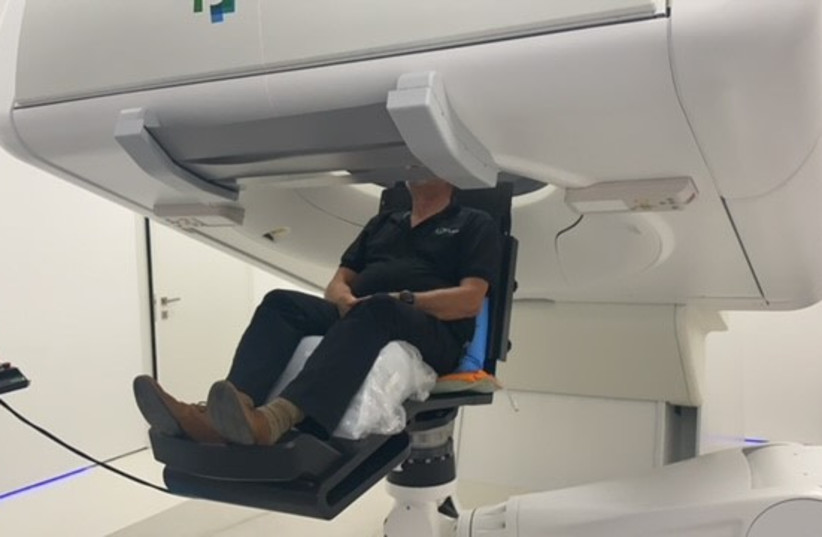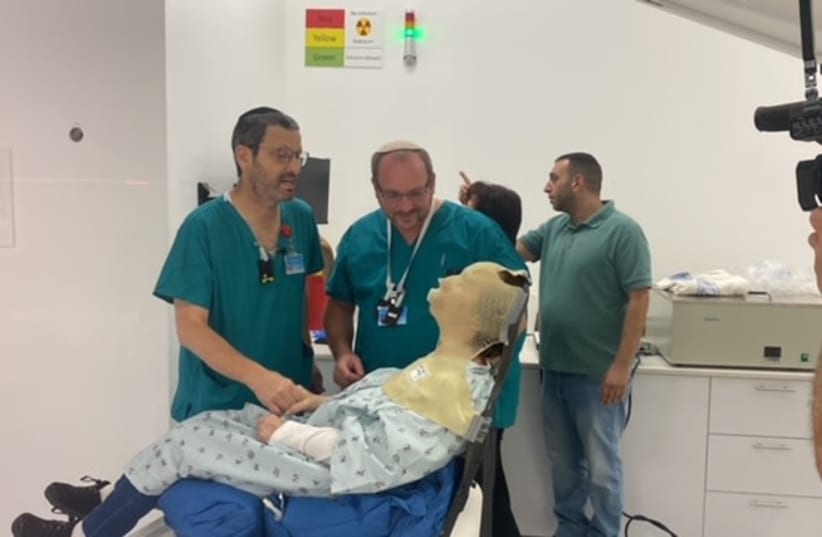The world’s only proton-beam machine for irradiating cancers that puts patients in a chair that moves as the beam stays stationary – an Israeli invention that is cheaper, smaller, safer, and more efficient than other devices that force the patient to remain still while the beam moves around – was opened last night at P-Cure Ltd’s Shilat facility near Modi’in.
The Proton Irradiation Center is the result of a collaboration between the Hadassah University Medical Center in Jerusalem’s Ein Kerem and the P-Cure company. It provides treatment to cancer patients without side effects as part of a groundbreaking experimental treatment. Eventually, Hadassah – which was chosen by P-Cure to collaborate – will build a home for the device next to its Sharett Institute of Oncology in Ein Kerem.
The first treatments in Israel were given to Rina and Haya, octogenarian cancer patients with tumors in the neck and mouth who had already lost hope with conventional treatments that failed and with the return of the disease.
Now, Hadassah Medical Organization (HMO) director-general Prof. Yoram Weiss told The Jerusalem Post, their condition has improved and the malignancies have disappeared. To confirm this, they have to undergo PET/CT scans in three months.
“The patient’s condition is good and their treatment is progressing satisfactorily, added Prof. Aron Popovtzer, director of the Sharett Institute told the Post. “In one woman who suffered from an extremely violent illness, the repeated tests carried out so far show a significant reduction.”



He feels at home at Hadassah, as his father, Prof. Mordechai Popovtzer, was for years head of the hospital’s nephrology department.
A groundbreaking experimental treatment
The collaboration will now allow dozens of Israeli cancer patients to receive treatment with proton irradiation as part of a groundbreaking experimental treatment that arouses great hope among thousands of patients and members of the health systems in Israel and around the world. HMO has received permission from the Health Ministry to begin experimentally treating hand-and-neck and recurring brain cancers.
“Initially, we will start with patients who have no other treatment options and patients with growths that are too close to strategic parts of the body and therefore cannot be treated with regular radiation,” said Popovtzer.
But as time passes and more experience is gained, it could be expanded to treat patients with cancers at the base of the skull, in the spinal cord, and cancers of the breast, lungs, liver, rectum, eye, prostate, and bone.
As the treatment has not been available here, those who wanted to undergo it had to fly for an extended period of treatment abroad and finance the entire procedure themselves (with a total cost of around $100,000).
Depending on the size, location, and number of tumors, the procedure takes only about 15 to 30 minutes in the treatment room including positioning the patient and calibrating the machine before generating a proton beam. The team first takes X-rays or CT-scan pictures so the protons hit the tumor and avoid healthy tissues nearby.
Marash added that the radiation system knows how to identify and focus on the cancerous growth itself and to identify changes within, even small ones, toward which treatment is then focused.
In the handful of proton-treatment facilities manufactured mostly by three companies, the machine has a “gantry” that rotates around the person. These can be very large, sometimes as tall as three stories, and the beam rotates at 270-degree circles, eight or nine meters long. But the P-Cure system has the patient moving as if on a gentle rollercoaster so the device can be much smaller and the beam more focused.
Innovative and painless
“When I heard that there is an innovative Hadassah treatment that is less painful and more focused than the treatments I have undergone so far and that one could undergo it for the first time in Israel and not fly abroad, I decided to give it one last chance,” said Rina.
“The doctor who has accompanied me for several years throughout the illness, Prof. Popovtzer, chose me to undergo the treatment and I am full of gratitude to him for this decision. Now I allow myself to be more optimistic, and my family who accompanies me to every treatment and examination are just as excited.”
Haya suffered for a long period from head and neck tumors, but after prolonged treatments according to the protocols, the tumors returned, so she too was chosen for proton beam irradiation.
The clinical trial, which is carried out at no cost to the health funds and the patients themselves and is approved by the US Food and Drug Administration (FDA), is a rare opportunity to make innovative treatment available to the Israeli patient.
The P-Cure company was established in 2007 and has been working to develop, produce and install proton-irradiation systems for cancer treatment. The company emphasizes that more than half of cancer patients in the world are treated with radiation as a single treatment or in combination with surgery or drug treatments, with the vast majority of radiation treatments being performed with the help of X-rays.
Despite the widespread use of X-rays, it is not targeted, so it causes many side effects and damage to healthy tissues adjacent to the malignancy. With the help of a new technology of treatment with proton beams instead of X-rays, more accurate and safer irradiation is possible, so the treatment is more effective and freer of side effects.
Despite the clinical potential, today only about one percent of all hospitals in the world have adopted the innovative technology. The low rate of adoption is due to the size of the existing projection systems, the required space, and the huge price of setting up and operating the systems.
Weiss concluded: “I am very happy that we have reached the moment when we officially inaugurate the center for proton irradiation in Israel and the treatment of the first patients in Israel as part of the clinical trial, together with the P-Cure company with which we have been going hand in hand for several years. The close collaboration between our professionals, which include the oncology specialists, physicists, nurses and doctors, and the P-Cure team led us to the possibility of clinical use of the unique system.”
